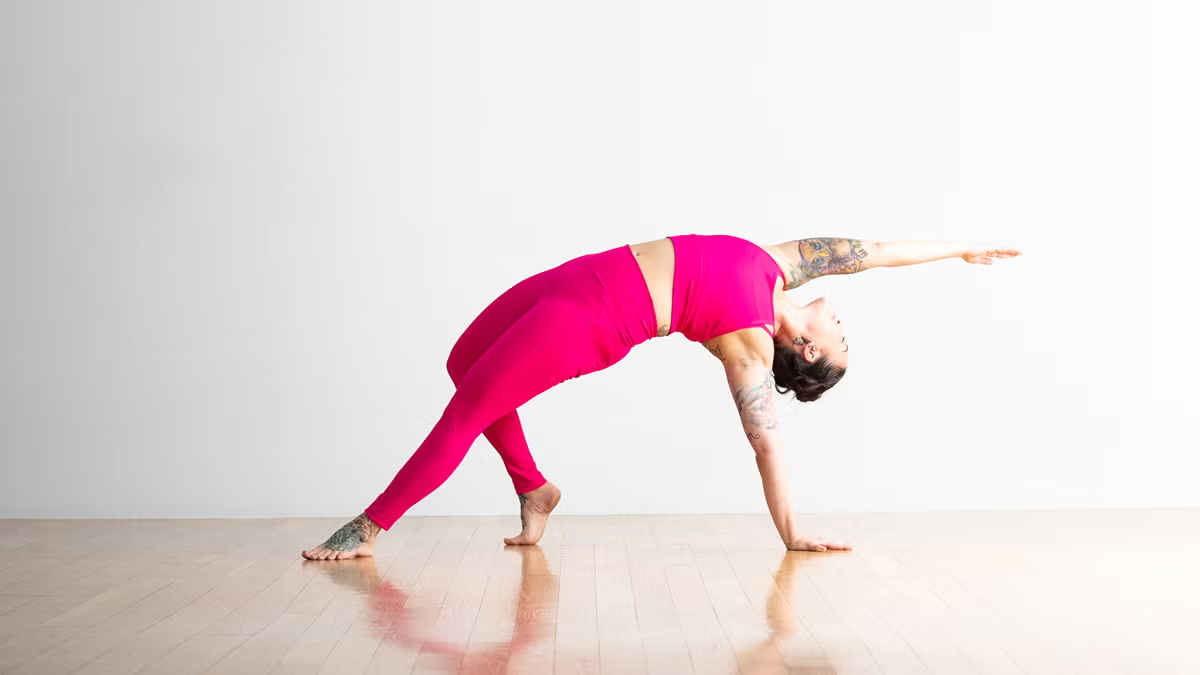Yoga is not only a practice of alignment and breath but also one of creativity and self-expression. Among the many beautifully named poses in yoga, the Fallen Star Pose stands out—both for its poetic name and its dynamic expression. Also referred to as Fallen Triangle, this pose is a powerful fusion of balance, core strength, and openness.
In this blog, we’ll dive into everything you need to know about Fallen Star Pose—from how to get into it safely, to its benefits, modifications, and frequently asked questions.
What is Fallen Star Yoga Pose?
Fallen Star Pose, commonly known as Fallen Triangle, is a transitional or peak pose in many Vinyasa-style yoga classes. It begins in a side plank variation and involves extending one leg under the body while lifting the opposite arm to the sky, creating a star-like shape.
Though it appears graceful and effortless, the pose demands strength, coordination, and focus. It’s a great way to challenge your balance while cultivating a sense of expansion and openness.
How to Practice Fallen Star Pose (Step-by-Step)
Starting from Downward-Facing Dog:
-
Begin in Downward-Facing Dog.
-
Inhale, and lift your right leg high into Three-Legged Dog.
-
Exhale, and bring your right knee toward your left elbow, engaging your core.
-
Extend your right leg under and across your body, placing the outer edge of your right foot on the floor (facing left).
-
Shift your weight onto your left hand and roll onto the outer edge of your left foot.
-
Inhale, and lift your right arm toward the ceiling, opening your chest.
-
Gaze up or forward, depending on your balance.
-
Hold the pose for 3–5 breaths.
-
To release, return the right hand to the mat and sweep the right leg back to Downward Dog. Repeat on the other side.
Benefits of Fallen Star Pose
Physical Benefits
-
Strengthens the shoulders, arms, and wrists
-
Builds core stability and endurance
-
Opens the chest and hips
-
Enhances coordination and overall balance
Mental and Emotional Benefits
-
Cultivates focus and body awareness
-
Encourages creative movement and self-expression
-
Provides a sense of expansion and lightness
Tips for Beginners
-
Warm up first with poses like Plank, Side Plank, and Twists.
-
If your bottom foot slides, try practicing on a yoga mat with good grip or use a yoga block for support.
-
Keep your lifted hand in line with your shoulder for better alignment.
-
Look straight ahead if gazing upward throws off your balance.
Variations and Modifications
-
Supported Variation: Keep your extended leg hovering off the floor for a more challenging core workout.
-
Simplified Version: Instead of extending the leg fully, keep it slightly bent or closer to your body.
-
Arm on Hip: If raising the top arm is difficult, rest your hand on your hip for stability.
When to Avoid Fallen Star Pose
Fallen Star Pose may not be suitable for those with:
-
Wrist, shoulder, or elbow injuries
-
Balance issues or vertigo
-
Limited core strength or flexibility (without proper warm-up or modification)
Always listen to your body and consult with a qualified yoga teacher if you’re unsure about any pose.
Conclusion
Fallen Star Pose is a beautiful blend of strength, grace, and dynamic movement. It challenges the body, engages the mind, and offers a moment of artistic expression on the mat. Whether you’re exploring creative transitions or deepening your vinyasa practice, this pose serves as a reminder that even in “falling,” there’s beauty, balance, and light.
Incorporate it into your flow when you feel ready to shine a little brighter and push your edge, while staying grounded in intention and breath.
Frequently Asked Questions (FAQs)
1. Is Fallen Star Pose a beginner-friendly pose?
It can be accessible to adventurous beginners with good core awareness, but it’s best practiced after building strength in foundational poses like Side Plank and Downward-Facing Dog.
2. What muscles does Fallen Star work?
This pose primarily engages the shoulders, obliques, abdominals, and glutes. It also stretches the chest and the hip of the extended leg.
3. What’s the difference between Fallen Star and Side Plank?
While both poses involve a similar upper-body structure, Fallen Star adds a leg extension across the body, making it more dynamic and demanding on the core and hips.
4. Can I modify Fallen Star if I have wrist pain?
Yes. You can try practicing the shape from a kneeling position or on your forearm, or by placing a yoga block under the supporting hand for extra height and support.
5. How long should I hold Fallen Star Pose?
Hold the pose for 3–5 breaths per side. Over time, you can increase the hold to 8–10 breaths as your strength and balance improve.





